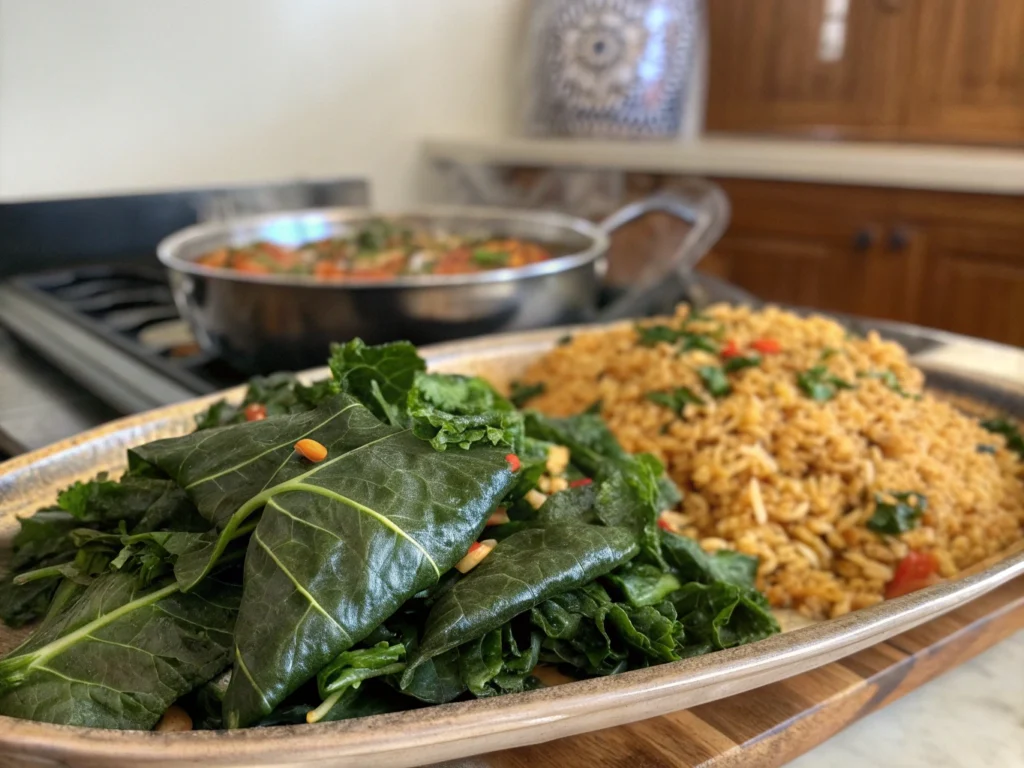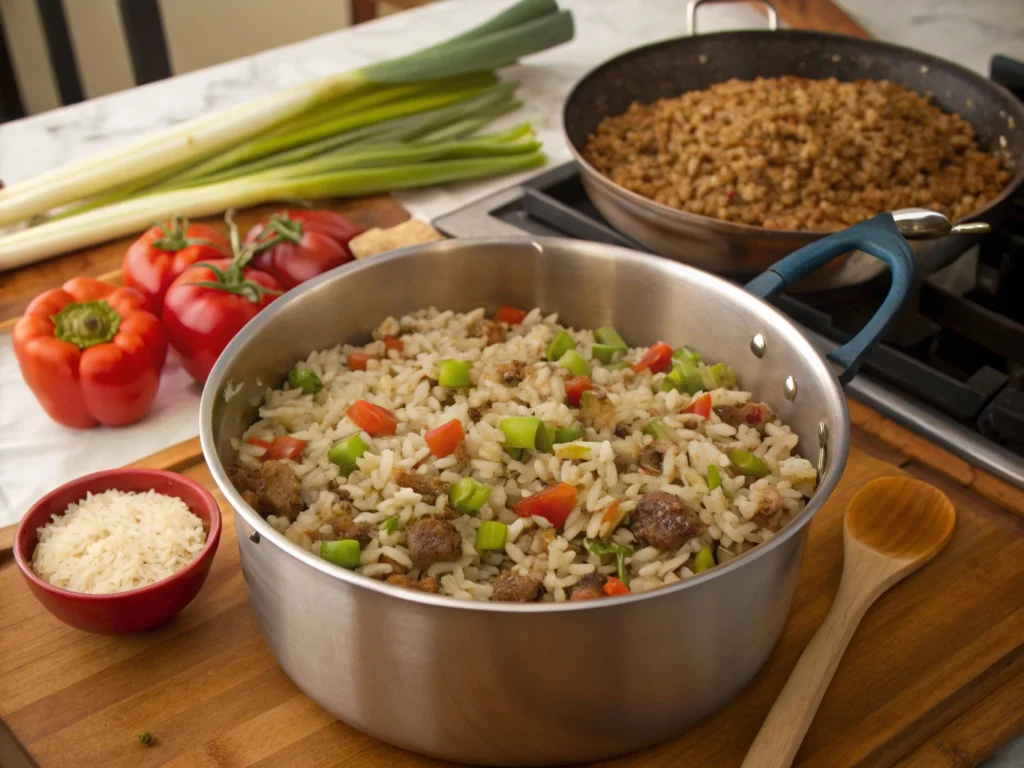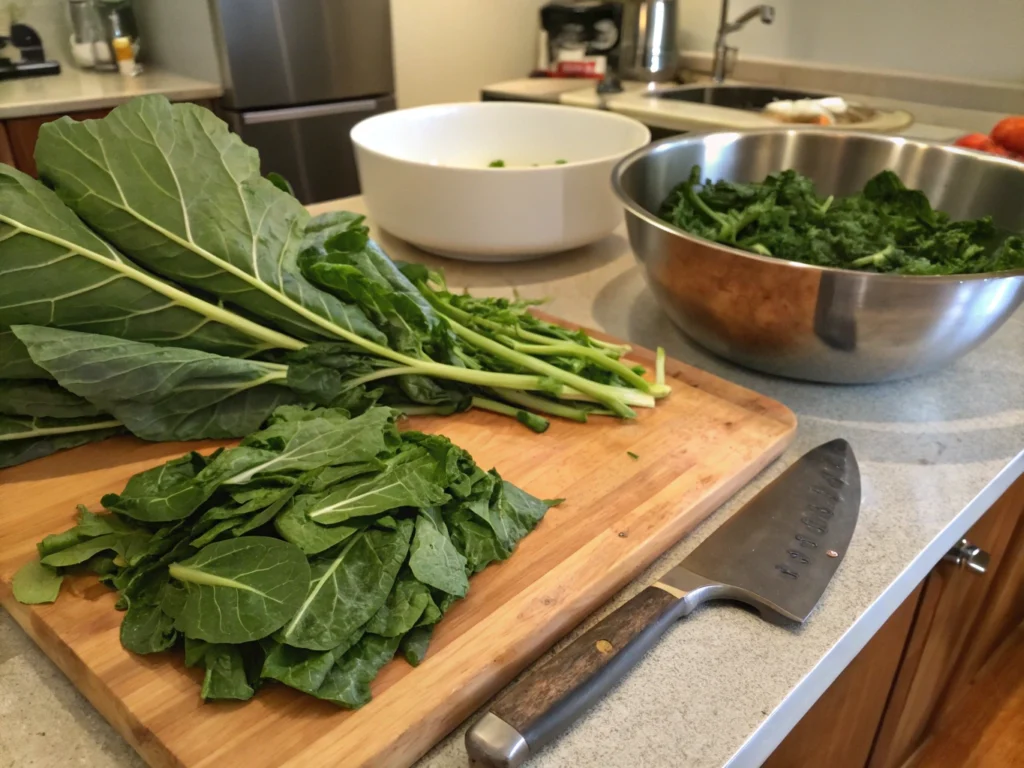The American South is a treasure trove of culinary wonders, rich in history and bursting with flavor. Among its beloved dishes, collard greens and dirty rice stand out as staples that blend tradition, taste, and nutritional value. This article dives deep into the roots, recipes, and benefits of these iconic foods, highlighting their role in Southern culture and cuisine. Whether you’re a foodie looking to try something new or a health-conscious eater exploring nutrient-rich dishes, you’re in for a flavorful journey. Let’s begin by exploring the fascinating traditions behind Southern cuisine.
The Southern Culinary Tradition
What Makes Southern Cuisine Unique?
Southern cuisine reflects a harmonious blend of cultural influences, including African, Native American, and European traditions. This melting pot of flavors gave rise to dishes that emphasize bold spices, fresh ingredients, and hearty portions. From fried chicken to gumbo, every meal tells a story of resilience and creativity. Southern food is also known for being comforting—there’s nothing like a warm plate of home-cooked goodness to bring people together.
The Role of Collard Greens in Southern Dishes
Collard greens have been a cornerstone of Southern cooking for centuries. These leafy greens, often slow-cooked with savory seasonings like onions, garlic, and smoked meat, are celebrated for their earthy taste and satisfying texture. Historically, they were a staple for enslaved Africans who made the most of humble ingredients, transforming collards into a dish full of heart and soul. Today, they remain a beloved side dish in Southern homes and restaurants.
The History of Dirty Rice and Its Cultural Roots
Dirty rice, a classic dish from Louisiana, owes its name to the “dirty” appearance created by mixing cooked rice with ground meat, spices, and vegetables. It originated as a way to make the most of affordable ingredients like chicken livers and gizzards. Over time, this humble dish evolved into a flavorful delicacy that represents the ingenuity of Southern cooks. Whether served as a main course or a side, dirty rice is a must-try dish for anyone craving authentic Creole flavors.
Understanding Collard Greens
What Are Collard Greens?
Collard greens are a leafy green vegetable from the brassica family, closely related to kale and cabbage. These robust, dark green leaves have a slightly bitter flavor that mellows beautifully when cooked. Known for their versatility, collards have long been a staple in Southern cooking, where they’re often prepared with savory seasonings to complement a variety of dishes.
Nutritional Benefits of Collard Greens
Rich in vitamins A, C, and K, collard greens are a powerhouse of nutrients. They’re also high in calcium and iron, making them an excellent choice for bone and blood health. Moreover, these greens pack a hefty dose of dietary fiber, which supports digestion and promotes a feeling of fullness. Incorporating collards into your meals not only boosts flavor but also contributes to a balanced diet. It’s easy to see why they’re a perfect fit in dishes like collard greens and dirty rice.
Collard Greens in Traditional and Modern Recipes
In Southern kitchens, collard greens are often slow-cooked with ingredients like smoked turkey or ham hocks, imparting a rich, smoky flavor. Modern twists on the classic preparation include sautéing them with garlic and olive oil or adding them to soups and stews. They’re even making their way into smoothies and wraps as health-conscious eaters embrace their benefits. Whether traditional or modern, these greens add depth and nutrition to every meal.
Dirty Rice: A Classic Southern Staple
What Is Dirty Rice?
Dirty rice is a seasoned rice dish that combines the rich flavors of ground meat, vegetables, and bold spices. The “dirty” in its name comes from the browned bits of meat that blend with the rice, giving it its characteristic color and deep flavor. Often considered comfort food, this dish embodies the essence of Southern cooking: hearty, flavorful, and satisfying.
Key Ingredients in Traditional Dirty Rice
The backbone of dirty rice lies in its simple yet flavorful ingredients. Classic recipes include white rice, ground sausage or chicken liver, onions, bell peppers, and celery, often referred to as the “holy trinity” in Creole cooking. Spices like paprika, cayenne, and thyme elevate the dish, creating layers of flavor that are both bold and complex. This mix of ingredients ensures that dirty rice pairs perfectly with collard greens and dirty rice: Southern recipes and benefits.
Regional Variations of Dirty Rice Recipes
Across the South, dirty rice recipes vary depending on local tastes and available ingredients. In Louisiana, for example, cooks often add Andouille sausage or seafood for a Creole twist. In other regions, milder seasonings and vegetables take center stage. Regardless of the variation, dirty rice continues to be a beloved staple, cherished for its adaptability and robust taste.
The Perfect Combination: Collard Greens and Dirty Rice

Why Pair Collard Greens with Dirty Rice?
When you think of Southern comfort food, collard greens and dirty rice naturally come to mind. The combination strikes a perfect balance of flavors and textures: the earthy bitterness of collard greens offsets the rich, savory notes of dirty rice. Together, they create a meal that’s not only satisfying but also packed with nutrients. Historically, this pairing was a practical choice, offering an affordable and nourishing way to feed families using seasonal ingredients and pantry staples.
Complementary Flavors and Textures
The robust flavor of collard greens contrasts beautifully with the aromatic spices and hearty proteins found in dirty rice. The greens bring freshness and a slight chew, while the rice delivers warmth and depth. To enhance the dish further, a splash of hot sauce or a squeeze of lemon adds brightness, rounding out the flavors for a truly memorable meal.
Recipe Spotlight: Collard Greens Creole Dirty Rice
For a delicious twist on tradition, try a Collard Greens Creole Dirty Rice recipe. This dish incorporates the “holy trinity” of Creole cooking—onions, celery, and bell peppers—along with garlic and smoked sausage. Freshly chopped collard greens are stirred in toward the end of cooking, allowing them to retain their texture while infusing the rice with their signature taste. It’s a one-pot wonder that brings the best of Southern cuisine to your table.
(For more hearty Southern recipes, check out our feature on Black-Eyed Peas and Collard Greens.)
Cooking Techniques for Collard Greens and Dirty Rice

How to Prepare and Clean Collard Greens
Before cooking collard greens, it’s essential to clean them thoroughly. Start by rinsing the leaves under cool water to remove dirt and grit. For a deeper clean, soak them in a bowl of water with a splash of vinegar. Once cleaned, strip the tough stems by folding each leaf in half and slicing along the vein. Stack the leaves, roll them into a cylinder, and slice them into ribbons for even cooking.
Cooking Methods: Sautéing, Boiling, and Steaming
Collard greens can be prepared in several ways. For a quick sauté, heat olive oil in a skillet, add garlic and onions, and toss in the greens. For a more traditional approach, boil the greens with smoked turkey or ham hocks for a smoky, tender result. Steaming is another option, preserving the greens’ nutrients while softening their texture.
Step-by-Step Guide to Making Dirty Rice

To make authentic dirty rice, start by cooking ground sausage or chicken livers in a large skillet. Remove the meat and sauté onions, celery, and bell peppers in the rendered fat. Add garlic, spices like paprika and cayenne, and long-grain rice. Return the cooked meat to the pan, pour in chicken stock, and simmer until the rice absorbs the liquid. Stir in fresh herbs and chopped scallions for a final touch.
Health Benefits of Collard Greens and Dirty Rice
Rich in Vitamins and Minerals
Collard greens and dirty rice are more than just tasty—they’re loaded with health benefits. Collard greens are an excellent source of vitamins A, C, and K, which support immunity, skin health, and bone strength. Dirty rice, depending on its ingredients, often contains essential nutrients like iron, protein, and potassium. Together, these dishes provide a nutrient-dense meal that fuels your body and satisfies your taste buds.
Boosting Gut Health with Fiber-Rich Ingredients
Both collard greens and dirty rice contribute to a fiber-rich diet, which promotes healthy digestion and gut health. The greens’ natural fiber aids in regulating bowel movements, while rice helps balance the meal with a satisfying carb base. Additionally, the inclusion of garlic, onions, and spices in these dishes adds prebiotic benefits, feeding good gut bacteria and improving overall digestive health.
Low-Calorie, High-Flavor Southern Cooking
One of the standout benefits of this pairing is how it manages to be both indulgent and healthy. Collard greens are naturally low in calories and fat, making them a guilt-free addition to your plate. By opting for lean meats and whole-grain rice in your dirty rice recipe, you can create a dish that’s as good for your body as it is for your palate. It’s no wonder Collard Greens and Dirty Rice: Southern Recipes and Benefits are celebrated in kitchens everywhere.
FAQs: Answering Popular Questions
What Can I Use as a Substitute for Collard Greens?
If you’re out of collard greens, don’t worry—there are plenty of alternatives that work just as well. Kale is a popular substitute, as it shares a similar texture and slightly bitter flavor. Swiss chard is another excellent option, offering a milder taste and a touch of sweetness. Mustard greens can also step in, bringing a peppery kick to your dish. For those who prefer a more neutral flavor, spinach or even Napa cabbage can be used, especially in recipes like Collard Greens and Dirty Rice: Southern Recipes and Benefits. When substituting, remember to adjust the cooking time slightly, as some greens cook faster than others.
Can Dirty Rice Be Made Vegetarian?
Yes, dirty rice can easily be adapted into a vegetarian or even vegan dish without losing its signature flavor. Swap out the traditional ground meat or chicken liver for plant-based sausage, crumbled tofu, or diced mushrooms. Mushrooms, especially varieties like cremini or shiitake, provide a meaty texture and umami flavor that mimic the richness of meat. Use vegetable broth instead of chicken stock, and amp up the spices to maintain that classic dirty rice zest. Adding smoked paprika or liquid smoke can also give your vegetarian version a smoky depth. This adjustment ensures you can still enjoy the benefits of Collard Greens and Dirty Rice while accommodating dietary preferences.
How Do I Store Leftover Collard Greens and Dirty Rice?
Proper storage is key to preserving the flavors of your dish. To store leftovers, let the food cool to room temperature before transferring it to airtight containers. Keep the collard greens and dirty rice separate if possible, as this makes reheating easier. Place the containers in the refrigerator, where they’ll stay fresh for up to three days.
When it’s time to reheat, use a skillet over low heat, adding a splash of water or broth to prevent the dish from drying out. For longer storage, freezing is an option. Portion the dish into freezer-safe containers or bags, label them with the date, and freeze for up to three months. When you’re ready to eat, thaw the portions overnight in the fridge and reheat gently. Freezing ensures you always have a taste of Collard Greens and Dirty Rice: Southern Recipes and Benefits ready to enjoy.
What Are Some Creative Ways to Serve Collard Greens and Dirty Rice?
While these dishes shine on their own, they can also be paired with other foods to create a complete meal. Serve dirty rice alongside roasted chicken, grilled fish, or even a plant-based protein for added variety. Collard greens work wonderfully as a side to cornbread or mashed sweet potatoes, creating a balanced Southern-inspired spread.
You can also get creative with presentations. Wrap collard greens around a scoop of dirty rice for a handheld, wrap-style snack, or use them to line a casserole dish for a visually appealing centerpiece. By thinking outside the box, you can turn these classic dishes into something uniquely your own.
Are Collard Greens and Dirty Rice Kid-Friendly?
Absolutely! While the bold flavors of these dishes might seem sophisticated, they can be easily adjusted to suit younger palates. To make dirty rice more appealing to kids, tone down the spices and opt for milder proteins like ground turkey. Similarly, you can prepare collard greens with a hint of sweetness by adding a touch of honey or apple cider vinegar to balance the bitterness. Serving these dishes as part of a fun, colorful plate can also encourage kids to try them.
By tailoring the preparation, Collard Greens and Dirty Rice: Southern Recipes and Benefits become not only family-friendly but also a great way to introduce children to diverse flavors and wholesome ingredients.
Conclusion: A Celebration of Southern Flavor and Nutrition
Collard Greens and Dirty Rice: Southern Recipes and Benefits showcase the rich culinary heritage of the South while delivering both flavor and nutrition. From their humble origins to their modern adaptations, these dishes have remained a staple of Southern cooking, cherished for their taste and versatility. Whether you’re embracing traditional recipes or experimenting with creative twists, collard greens and dirty rice offer something for everyone.
As you explore the recipes and techniques outlined in this article, remember that the heart of Southern cooking lies in its ability to bring people together. Share these dishes with family and friends, and let their flavors tell a story of culture, history, and comfort.

